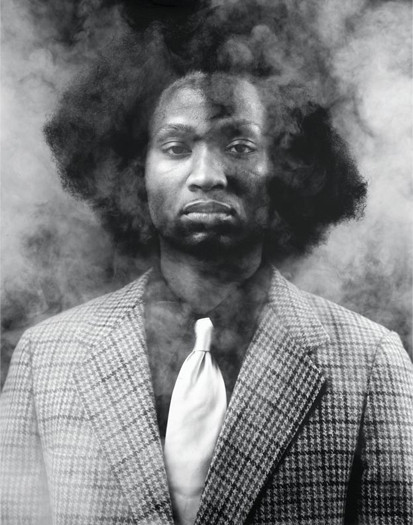30 Americans
03 Dec 2008 - 30 May 2009

The New Negro Escapist Social and Athletic Club (Thurgood), 2008
Lambda print, Ed. 2/5
69 x 55 1/2 in. (17
December 3, 2008 - May 30, 2009
Nina Chanel Abney, John Bankston, Jean-Michel Basquiat, Mark Bradford, Iona Rozeal Brown, Nick Cave, Robert Colescott, Noah Davis, Leonardo Drew, Renée Green, David Hammons, Barkley L. Hendricks, Rashid Johnson, Glenn Ligon, Kalup Linzy, Kerry James Marshall, Rodney McMillian, Wangechi Mutu, William Pope.L, Gary Simmons, Xaviera Simmons, Lorna Simpson, Shinique Smithm, Jeff Sonhouse, Henry Taylor, Hank Willis Thomas, Mickalene Thomas, Kara Walker, Carrie Mae Weems, Kehinde Wiley, Purvis Young
Inside Our Process | Rubell Family
We only show art we own. That is a founding principle of the Rubell Family Collection, a principle that gives us tremendous freedom and enormous constraints. When we set out to conceptualize a new exhibition, we know we will only get the depth and quality we seek if we already have a strong foundation of works by a core group of artists. Once the exhibition is determined, we then collect into it, buying works that we consider essential right up to the closing date for the catalogue, just one month before the opening of the show.
In general, the spark for a new exhibition begins in artists’ studios. The artists often talk about earlier artists who influence or inspire them. When we start hearing the same names over and over, and many members of the more established generation are already well represented in our collection, we begin to think that there’s a show to be done.
We then embark on a mission to both expand our commitment to the older generation—including some artists that we have only begun to understand through the eyes of the emerging generation—and collect this new generation in as much depth and breadth as possible. This entire endeavor is limited by the availability of great work, financial resources, and time. We depend on significant cooperation from artists, gallerists, curators, and the greater art community, and we have been moved by how willing everyone has been to help us create the very best show we can, every time. This process—conceptualizing the show, collecting additional works for it, curating it and publishing a catalogue—generally takes about three years.
Our shows are created in real time. These exhibitions are not comprehensive; each represents our family’s personal view of what we are most excited about in art at this very moment, without the luxury or constraints of historical perspective. Because many of the artists are not broadly known, we make every effort to collect and exhibit each artist in the greatest depth possible. This becomes especially important as the show travels to various venues, particularly university museums, where students may be encountering most of the artists for the first time. We also publish a major catalogue to accompany each show, with critical essays that provide a framework through which students, artists, and the general public can gain a maximum understanding of the artists, the movements and the themes involved in a given exhibition.
Since we started collecting in the 1960s, we have always collected African-American artists as a part of our broader mission to collect the most interesting art of our time. Approximately three years ago, we found there was a critical mass of emerging African-American artists, and began the process of understanding what seemed to be a new movement. When we asked these artists about their influences, we heard some of the same names over and over: Robert Colescott, Renée Green, David Hammons, Barkley Hendricks, Kerry James Marshall, Gary Simmons, Lorna Simpson, Kara Walker, and Carrie Mae Weems. We had been collecting almost all of this older generation for decades. Perfect conditions for a new exhibition.
As we explored the possibility of a show, we were deeply influenced by a series of outstanding exhibitions around the country focusing on African-American artists, including the “Freestyle” and “Frequency” shows at the Studio Museum in Harlem; “Black Is, Black Ain’t” at the Renaissance Society; the Barkley Hendricks show at the Nasher Art Museum at Duke University; the David Hammons show at P.S.1; and the museum retrospectives of Glenn Ligon, Kerry James Marshall, Lorna Simpson and Kara Walker.
As we explored the possibility of a show, we were deeply influenced by a series of outstanding exhibitions around the country focusing on African-American artists, including the “Freestyle” and “Frequency” shows at the Studio Museum in Harlem; “Black Is, Black Ain’t” at the Renaissance Society; the Barkley Hendricks show at the Nasher Art Museum at Duke University; the David Hammons show at P.S.1; and the museum retrospectives of Glenn Ligon, Kerry James Marshall, Lorna Simpson and Kara Walker.
We have spent the last three years traveling everywhere we can, speaking to as many artists, critics, and curators as we can, finding and acquiring the best work we can, and putting together the best possible portrait of contemporary African-American art that our physical, financial and intellectual limitations allow. The result is a show of more than 200 works of art, exhibited in 27 galleries occupying the entire 45,000-square-foot exhibition space of the Rubell Family Collection.
As the show evolved, we decided to call it “30 Americans.” “Americans,” rather than “African Americans” or “Black Americans” because nationality is a statement of fact, while racial identity is a question each artist answers in his or her own way, or not at all. And the number 30 because we acknowledge, even as it is happening, that this show does not include everyone who could be in it. The truth is, because we do collect right up to the last minute before a show, there are actually 31 artists in “30 Americans.”
November 2008
Rubell Family
